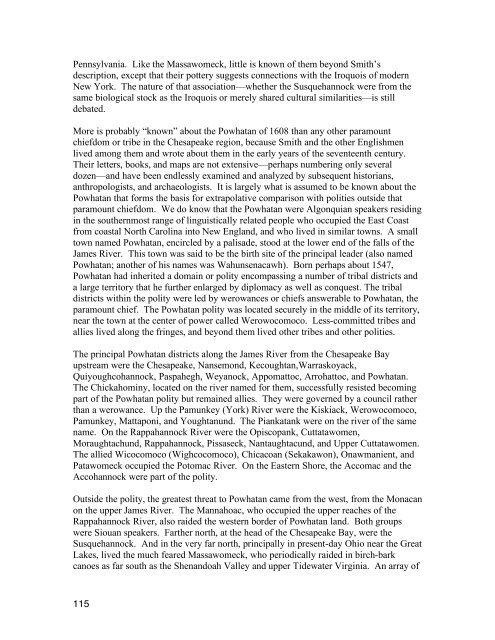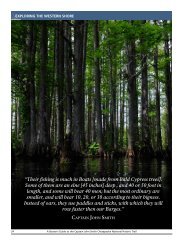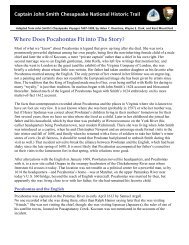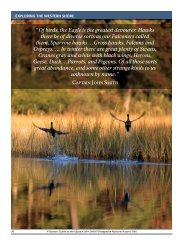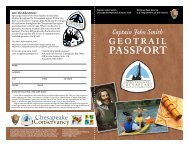Draft Interpretive Plan Join the adventure! - Captain John Smith ...
Draft Interpretive Plan Join the adventure! - Captain John Smith ...
Draft Interpretive Plan Join the adventure! - Captain John Smith ...
You also want an ePaper? Increase the reach of your titles
YUMPU automatically turns print PDFs into web optimized ePapers that Google loves.
Pennsylvania. Like <strong>the</strong> Massawomeck, little is known of <strong>the</strong>m beyond <strong>Smith</strong>’s<br />
description, except that <strong>the</strong>ir pottery suggests connections with <strong>the</strong> Iroquois of modern<br />
New York. The nature of that association—whe<strong>the</strong>r <strong>the</strong> Susquehannock were from <strong>the</strong><br />
same biological stock as <strong>the</strong> Iroquois or merely shared cultural similarities—is still<br />
debated.<br />
More is probably “known” about <strong>the</strong> Powhatan of 1608 than any o<strong>the</strong>r paramount<br />
chiefdom or tribe in <strong>the</strong> Chesapeake region, because <strong>Smith</strong> and <strong>the</strong> o<strong>the</strong>r Englishmen<br />
lived among <strong>the</strong>m and wrote about <strong>the</strong>m in <strong>the</strong> early years of <strong>the</strong> seventeenth century.<br />
Their letters, books, and maps are not extensive—perhaps numbering only several<br />
dozen—and have been endlessly examined and analyzed by subsequent historians,<br />
anthropologists, and archaeologists. It is largely what is assumed to be known about <strong>the</strong><br />
Powhatan that forms <strong>the</strong> basis for extrapolative comparison with polities outside that<br />
paramount chiefdom. We do know that <strong>the</strong> Powhatan were Algonquian speakers residing<br />
in <strong>the</strong> sou<strong>the</strong>rnmost range of linguistically related people who occupied <strong>the</strong> East Coast<br />
from coastal North Carolina into New England, and who lived in similar towns. A small<br />
town named Powhatan, encircled by a palisade, stood at <strong>the</strong> lower end of <strong>the</strong> falls of <strong>the</strong><br />
James River. This town was said to be <strong>the</strong> birth site of <strong>the</strong> principal leader (also named<br />
Powhatan; ano<strong>the</strong>r of his names was Wahunsenacawh). Born perhaps about 1547,<br />
Powhatan had inherited a domain or polity encompassing a number of tribal districts and<br />
a large territory that he fur<strong>the</strong>r enlarged by diplomacy as well as conquest. The tribal<br />
districts within <strong>the</strong> polity were led by werowances or chiefs answerable to Powhatan, <strong>the</strong><br />
paramount chief. The Powhatan polity was located securely in <strong>the</strong> middle of its territory,<br />
near <strong>the</strong> town at <strong>the</strong> center of power called Werowocomoco. Less-committed tribes and<br />
allies lived along <strong>the</strong> fringes, and beyond <strong>the</strong>m lived o<strong>the</strong>r tribes and o<strong>the</strong>r polities.<br />
The principal Powhatan districts along <strong>the</strong> James River from <strong>the</strong> Chesapeake Bay<br />
upstream were <strong>the</strong> Chesapeake, Nansemond, Kecoughtan,Warraskoyack,<br />
Quiyoughcohannock, Paspahegh, Weyanock, Appomattoc, Arrohattoc, and Powhatan.<br />
The Chickahominy, located on <strong>the</strong> river named for <strong>the</strong>m, successfully resisted becoming<br />
part of <strong>the</strong> Powhatan polity but remained allies. They were governed by a council ra<strong>the</strong>r<br />
than a werowance. Up <strong>the</strong> Pamunkey (York) River were <strong>the</strong> Kiskiack, Werowocomoco,<br />
Pamunkey, Mattaponi, and Youghtanund. The Piankatank were on <strong>the</strong> river of <strong>the</strong> same<br />
name. On <strong>the</strong> Rappahannock River were <strong>the</strong> Opiscopank, Cuttatawomen,<br />
Moraughtachund, Rappahannock, Pissaseck, Nantaughtacund, and Upper Cuttatawomen.<br />
The allied Wicocomoco (Wighcocomoco), Chicacoan (Sekakawon), Onawmanient, and<br />
Patawomeck occupied <strong>the</strong> Potomac River. On <strong>the</strong> Eastern Shore, <strong>the</strong> Accomac and <strong>the</strong><br />
Accohannock were part of <strong>the</strong> polity.<br />
Outside <strong>the</strong> polity, <strong>the</strong> greatest threat to Powhatan came from <strong>the</strong> west, from <strong>the</strong> Monacan<br />
on <strong>the</strong> upper James River. The Mannahoac, who occupied <strong>the</strong> upper reaches of <strong>the</strong><br />
Rappahannock River, also raided <strong>the</strong> western border of Powhatan land. Both groups<br />
were Siouan speakers. Far<strong>the</strong>r north, at <strong>the</strong> head of <strong>the</strong> Chesapeake Bay, were <strong>the</strong><br />
Susquehannock. And in <strong>the</strong> very far north, principally in present-day Ohio near <strong>the</strong> Great<br />
Lakes, lived <strong>the</strong> much feared Massawomeck, who periodically raided in birch-bark<br />
canoes as far south as <strong>the</strong> Shenandoah Valley and upper Tidewater Virginia. An array of<br />
115


